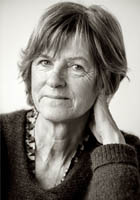Miriam Van hee Biography
Miriam Van hee (Flanders, 1952) debuted in 1978 with her poems about homesickness, melancholy and loneliness. To her displeasure she was classified by the critics as neoromantic, the predominant trend in Flemish poetry at that time.
Nevertheless, her poetry is not a flight from reality, as Van hee does broach realistic subjects. Her style is also close to spoken language and appears, if anything, cautious. Falteringly, the poetess attempts to come to terms with the world, while holding on to the familiar. The reader imagines himself safe in her world, an illusion that is often suddenly dashed.
1
the lady from latvia recounted
how the people ended up where they did:
the finns steadily pushed the lapps
northwards
...
the air may have been more rarified then
and the wind cooler, the sun had
a different status, but nevertheless
...
there are gardens that have escaped someone's
watchful eye and in them the sky is as clear
and as cool as a sea breeze in the south can be
you sit at a table and talk to the neighbours, you drink
...
hesitantly we follow the charted glass route
we immerse ourselves in a city map,
identifying places we know so well
...
wij volgen onwennig een glazen parcours
wij buigen ons over een stadsplattegrond
we brengen er plekken in thuis, die ons
's nachts als daglicht voor ogen staan
daar is het, tussen het postkantoor en het
gehavende parkje, daar stond die wilg
die moest omgehakt worden, daar is
de speeltuin, het zwembad, verlangen
bevangt ons, en huiver, zoals wij hier nu
in ons tijdelijk schoeisel van plastic
de donkere kanten van de straten aftasten,
een huis aan de spoorweg waarin wij
niet ziek zijn geworden maar ouder,
het zweven gestopt is, het zoeken
naar een verband, en daar op de hoek,
voor de boekhandelaar, daar wachtten
wij vaak op de tram, en in dat wachten
het sneeuwen begon, over alles en ons
...
